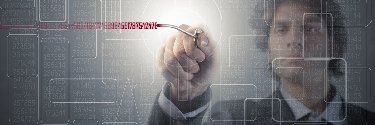Web application framework and Java middleware
Web application frameworks help enterprise application developers focus on the business logic that makes enterprise application indispensable without focusing too much effort on ensuring that the applications work across browser platforms. The write once, run anywhere promise of the Java language only extends so far. Server-side developers must still concern themselves with Java integration into the enterprise architecture. Frequently, Java middleware platforms will be necessary to integrate enterprise Web applications.
Top Stories
-
Video
27 May 2020

HashMap vs. Hashtable: Which map should you choose?
When HashMap replaced Hashtable as part of the Java 1.2 release, it moved away from how developers previously used the collections API and Java maps. Continue Reading
By- Cameron McKenzie, TechTarget
-
Video
18 Apr 2019

Use Tomcat, Eclipse to create a JAX-RS REST web service
Use this step-by-step tutorial with an example rock-paper-scissors game to understand how to create and take advantage of RESTful web services with Eclipse and Tomcat. Continue Reading
By- Cameron McKenzie, TechTarget
-
Blog Post
09 Aug 2025

Apache Struts Hello World by example
Here's a simple Struts Hello World example for anyone interested in learning how to use the latest Struts 2.5 release. The Apache Struts Framework has come a long way in the last 20 years. Continue Reading
By- Cameron McKenzie, TechTarget
-
Blog Post
09 Aug 2025

Apache Struts 2.5 with no Struts config XML file example
Learn to develop a modern Java web application with this Apache Struts 2.5 example. No Struts config XML files are required. This zero-config Struts example goes without! Continue Reading
By- Cameron McKenzie, TechTarget
-
Blog Post
08 Aug 2025

Java's 4 JDBC driver types explained
Here we explain the difference between the four JDBC driver types, and how to choose the right JDBC driver for your database-driven Java apps. Continue Reading
By- Cameron McKenzie, TechTarget
-
Blog Post
28 Jul 2025

2023 Java roadmap for developers
This 2023 Java roadmap for developers will help guide your path as you build the skills required to go from a beginner programmer to an advanced software developer. Continue Reading
By- Cameron McKenzie, TechTarget
-
Blog Post
17 Jul 2025

How to format a Java table with printf example
Why not make your console output look pretty? Create, format and print data tables with Java printf statements, along with a clever combination of dashes, pipelines and printf placeholders. Continue Reading
By- Cameron McKenzie, TechTarget
-
Blog Post
25 Jun 2025

Simple Struts 2 file upload example
In this Struts 2 file upload example we show you to take a local resource and upload it to a remote Java application server. All a developer needs is a file, a browser and an Internet connection ... Continue Reading
By- Cameron McKenzie, TechTarget
-
Blog Post
10 Jun 2025

How to git push an existing project to Bitbucket
Follow these simple steps to push an existing project to a Bitbucket repo, and successfully add all of the code on your local machine into a remote Bitbucket repository. Continue Reading
By- Cameron McKenzie, TechTarget
-
Blog Post
19 Jul 2024

What do you think of TheServerSide's fresh new look?
Surely you've noticed? Everything is fresh, and there's entire list of new features. Here's a rundown on what's changed and why. Continue Reading
By- Cameron McKenzie, TechTarget
-
Definition
19 Jan 2023

web stack
A web stack is the collection of software used for web development that incorporates, at a minimum, an operating system (OS), a programming language, database software and a web server. Continue Reading
-
Definition
25 Jan 2022

AJAX (Asynchronous JavaScript and XML)
AJAX (Asynchronous JavaScript and XML) is a technique aimed at creating better and faster interactive web apps by combining several programming tools including JavaScript, dynamic HTML (DHTML) and Extensible Markup Language (XML). Continue Reading
By -
Blog Post
13 Sep 2020

Use the Struts jQuery plugin to simplify Ajax request cycles example
The Struts 2 Ajax template is deprecated, but the Strut jQuery plugin is a more than capable replacement. In this Struts jQuery tutorial we show you how to integrate Ajax calls into your modern ... Continue Reading
By- Cameron McKenzie, TechTarget
-
Blog Post
30 Jun 2020

A Bitnami WordPress stack installation and examination
Sometimes it's fun to see how components in open source projects are architected together. I installed a Bitnami WordPress stack onto my laptop Here I to see how the popular blogging platform works. Continue Reading
By- Cameron McKenzie, TechTarget
-
Video
27 May 2020

HashMap vs. Hashtable: Which map should you choose?
When HashMap replaced Hashtable as part of the Java 1.2 release, it moved away from how developers previously used the collections API and Java maps. Continue Reading
By- Cameron McKenzie, TechTarget
-
Blog Post
26 Feb 2020

Top Java frameworks for web app development
Client-side JavaScript frameworks are all the rage, but they aren't always the right answer if you want to deliver a web-based experience for your browser-based clients. If you want to distance ... Continue Reading
By- Cameron McKenzie, TechTarget
-
Blog Post
06 Aug 2019

3 questions to ask in a microservices oriented architecture review
Don't get caught up in all the microservices oriented architecture hype just yet. Make sure you ask some key questions, and examine potential design issues before you say yes. Continue Reading
By- Bob Reselman, CogArtTech
-
Blog Post
23 Apr 2019

Top 5 software development best practices you need to know
Sometimes software development best practices are obvious. But as well-known as some of them may be, they are often overlooked. Explore these five best practices to ensure a smooth deployment. Continue Reading
-
Video
18 Apr 2019

Use Tomcat, Eclipse to create a JAX-RS REST web service
Use this step-by-step tutorial with an example rock-paper-scissors game to understand how to create and take advantage of RESTful web services with Eclipse and Tomcat. Continue Reading
By- Cameron McKenzie, TechTarget
-
Video
10 Apr 2019

Follow this Java screen scraper example to aggregate content
Follow this JSoup example of screen scraping to aggregate data from live webpages, and generate results that can be easily identified and organized. Continue Reading
By- Cameron McKenzie, TechTarget
-
News
28 Mar 2019

JavaScript popularity drives TypeScript adoption among devs
More developers choose to work with JavaScript to build web, server-side and mobile applications, while TypeScript has quickly gained traction, according to recent analysis. Continue Reading
-
Feature
20 Feb 2019

Convert JPEG to SVG to improve webpage performance
Vector images open the door for multiple benefits on HTML webpages. Consider SVGs instead of raster images to boost HTML speed and improve overall image clarity. Continue Reading
By- Gail Mackenzie, Xennial Consulting Inc.
-
Blog Post
13 Feb 2019

Don't struggle to learn new programming languages
Developers need to learn new programming languages to stay ahead in their field and improve their skills. But, this can be a cumbersome process since people learn in different ways. Continue Reading
-
Blog Post
30 Nov 2018

DeepCode and AI tools poised to revolutionize static code analysis
Find out how AI promises to dramatically reshape the way developers analyze code for bugs, security issues, and performance improvements. Continue Reading
-
Blog Post
01 Nov 2018

To the brave new world of reactive systems and back
We explore the idea of reactive systems and learn how they are designed. Continue Reading
-
Blog Post
19 Jul 2018

The secret history behind the success of npm and Node
The CTO of npm, the free package manager driving JavaScript, explains the perfect storm behind the catastrophic success of JavaScript and Node.JS. Continue Reading
-
Feature
22 May 2018

Packaging Java programs in the modern age of microservices and mobile apps
The packaging of Java programs has taken an interesting turn, as the original JAR format becomes a favorite even for Java web apps deployed as microservices. Continue Reading
By- Cameron McKenzie, TechTarget
-
Feature
20 Mar 2018

Rust and Python top list of most popular development languages
A new Stack Overflow survey of over 100,000 developers indicated Java and JavaScript are not as popular as they had been before. Find out what developers really want to program with. Continue Reading
-
Feature
30 Jan 2018

What happened to Java in 2017? Here's a comprehensive list
Java developers face new technology challenges regularly, but in 2017, the bar was raised. We've rounded up our top 10 Java stories from 2017 in case you missed anything. Continue Reading
By- Ryan Dowd, Associate Site Editor
-
Podcast
04 Oct 2017

Manico and Grimstad bring Java tech to life at JavaOne 2017
Engaging speakers like Jim Manico or Ivar Grimstad can make all the difference when choosing a session at a conference like JavaOne 2017 than the session syllabus. Continue Reading
By- Cameron McKenzie, TechTarget
-
Podcast
03 Oct 2017

How Java EE Security and MVC 1.0 simplify Java microservices
Once the decision has been made to use containers and microservices, it's good to know that MVC 1.0 and the Java EE Security API will make the development process much easier. Continue Reading
By- Cameron McKenzie, TechTarget
-
Guide
29 Aug 2017

Top JavaScript frameworks accelerate software development
Despite its tough reputation, JavaScript frameworks are still growing in popularity in the software development world. Get the latest on JavaScript's status and future expectations. Continue Reading
-
Feature
25 Jul 2017

React and Angular frameworks speeding up JavaScript performance
New JavaScript frameworks, like React and Angular, are changing the way web and mobile UIs are developed, with performance being one of their strongest traits. Continue Reading
-
News
17 Feb 2017

Pass on the JSON, and choose binary encoding formats instead
Find out how developers can achieve significant performance boosts using new binary encoding formats as alternatives to JSON and XML. Continue Reading
-
Feature
16 Jan 2017

Web application performance tips from the wolves on Wall Street
If you are having web application performance problems, here are some tips from the IT experts working Wall Street. Continue Reading
-
Feature
27 Oct 2016

SVG graphics and HTML5 key to creating consistent UIs across devices
Find out how new libraries and tools promise to bring a consistent UI with SVG graphics in HTML5 development. Continue Reading
-
Tutorial
25 May 2016

Portlet tutorial: Defining and namespacing JavaScript objects
A great deal of frustration can ensue when referencing JavaScript objects within a portlet. Defining a namespacing JavaScript component properly will help avoid that. Continue Reading
By- Sal Pece
-
Feature
01 Apr 2016

Moving beyond the virtualization tool with DevOps containers
Virtualization has been a pivotal tool for organizations wanting to simplify both development and operations, but DevOps is now moving beyond the VM with DevOps containers. Continue Reading
By -
Feature
26 Feb 2016

In JDK 9, the Java browser plug-in will be a thing of the past
In the version 9 release of JDK, Oracle will finally drop the Java browser plug-in, and nobody is shedding a tear over it. Continue Reading
By- Cameron McKenzie, TechTarget
-
Tip
22 Feb 2016

Five tips for choosing a UI development framework
Choosing a UI development framework is one of the most difficult decisions a software architect must make. Here are five things to look for when picking a development framework. Continue Reading
By- Cameron McKenzie, TechTarget
-
Feature
13 Jan 2016

Why learning Scala, JavaScript and Ruby will make you a better Java developer
Obviously a JVM stack developer is going to know Java. But in this world of polyglot programming, knowing a bit of JavaScript, Ruby and Scala as well is a must. In fact, it might even make you a better Java developer. Continue Reading
By- Cameron McKenzie, TechTarget
-
Feature
10 Dec 2015

These new features in PHP 7 will convince you to do an upgrade
There have been some significant improvements to the PHP language. In this article we show you how to take advantage of them, and potentially convince you to do an upgrade and migrate to the new version. Continue Reading
-
Podcast
30 Jul 2015

Beat performance monitoring hurdles in single-page interface world
This podcast discusses how frameworks like AngularJS have simplified the creation of single-page interface applications, but have created new performance monitoring challenges. Continue Reading
By- Cameron McKenzie, TechTarget
-
Tutorial
04 May 2015

How to invoke a JSF managed bean asynchronously through JavaScript
Sometimes great frameworks like JSF, Wicket or Spring MVC make simple tasks surprisingly difficult to do. With JavaServer Faces, the simple task of invoking a method on a managed bean is actually a bit of a chore. In this tutorial, we tackle that chore together. Continue Reading
By- Cameron McKenzie, TechTarget
-
Tip
30 Apr 2015

How Netflix modularized their JavaScript Codebase
Netflix implemented a modularized JavaScript Codebase to accommodate growing user interface issues Continue Reading
-
Tip
29 Apr 2015

How elegant code can hurt HTML5 performance
Elegant code can lead to cleaner, precise steps. But it can also lead to application performance bottlenecks, argues Mozilla's Andreas Gal. Continue Reading
-
Feature
08 Jan 2015

10 reasons why HTML5 implementation should happen now
Learn the top 10 reasons why HTML5 implementation should be your next Web development project. Continue Reading
By- Asha Raman
-
Tip
28 Oct 2014

Incorporating Google Maps to the Java desktop
Rob Terpilowski discusses how he and his architect team brought Google Maps to the Java desktop in this video from JavaOne 2014. Continue Reading
By- Cameron McKenzie and Jan Stafford
-
Feature
18 Aug 2014

HTML5 now rules the desktop, but shortcomings make it a hard sell for mobile
HTML5 is changing the game for both mobile and desktop developers, but that doesn't mean HTML5 is a panacea. Performance problems, a lack of tooling and missing features are causing a roadblock for some organizations, especially in the mobile space. Should you go with HTML5, or is a hybrid or native approach right for you? Continue Reading
-
Tutorial
20 Jul 2014

Integrating Ajax into your Facelets pages: Death to JSF's request-response cycle
If you're doing Facelets development, this might be the most important tutorial you will ever read. It will explain to you how to throw out that annoying request-response cycle, and explain how to integrate Ajax based JSF components with a dynamically re-rendering Facelets page snippet. Continue Reading
By- Cameron McKenzie, TechTarget
-
Tutorial
20 Jul 2014

Template based web design with JSF Facelets: ui:insert versus ui:include
When creating a web page template with JSF, a developer needs to know the difference between ui:insert and ui:include. They're actually quite different, but the similar sounding names can create confusion. Here's a great example of when to use ui:insert and how to properly use ui:include. Continue Reading
By- Cameron McKenzie, TechTarget
-
Tutorial
20 Jul 2014

Creating pages based on a JSF template: Using the Facelets ui:define tag
What do you do once you've set up a handsome page template using the Facelets functions that come with JSF 2.x? Well, you start creating new pages, meshing those ui:define tags in with ui:composition and ui:insert. It's easier than it sounds, trust me. Continue Reading
By- Cameron McKenzie, TechTarget
-
Tutorial
19 Jul 2014

An introduction to template building with Facelets, CSS, HTML and JSF 2.2
Facelets is a great technology for creating templates for websites and then adding dynamic functionality. In this tutorial, we will introduce the idea of creating a template page with CSS, HTML, JavaScript and JavaServer Faces 2.2 (JSF). Continue Reading
By- Cameron McKenzie, TechTarget
-
Tutorial
18 Feb 2014

How to animate your web pages using JavaScript, HTML and CSS: A tutorial
One of the great benefits to using JavaScript is the fact that it allows you to animate your web pages in simple yet creative ways. Here we look at a simple example that animates the result of a game or rock-paper-scissors. Continue Reading
By- Cameron McKenzie, TechTarget
-
Tutorial
17 Feb 2014

Tutorial: Coding a simple Rock Paper Scissors application in JavaScript
Rock, paper scissors, or Rashambo as it is called in some circles, is a simple game that most people understand, which makes it a great scenario for learning how to program in JavaScript. Continue Reading
By- Cameron McKenzie, TechTarget
-
Tutorial
17 Feb 2014

A simple tutorial on using the JavaScript event model
To be great at JavaScript languages like JQuery, Dojo and YUI, you must master the basics of JavaScript. Here we look at implementing a simple Roshambo application using the JavaScript event model. Continue Reading
By- Cameron McKenzie, TechTarget
-
Tutorial
27 Jul 2013

JSR-286 development tutorial: Linking back to the portal with the PortletURL
In this JSR-286 development tutorial we look at the PortletURL and the challenge developers face when trying to link back to the portal, a portal page or a given portlet instance. Continue Reading
By- Sal Pece
-
Tip
05 May 2013

Two most commonly misconfigured Tomcat performance settings
Tomcat on the server is different from Tomcat on the desktop, but too many system admins fail to optimize their production servers for performance. Continue Reading
By- Cameron McKenzie, TechTarget
-
Tip
12 Mar 2013

Performance and troubleshooting tips for JSF 2.0 Facelet developers
JSF 2.0 has provided a variety of new configuration settings to help improve performance and aid the troubleshooting task, making the lives of software developers and quality engineers much easier. Continue Reading
By- Lukas Stewart
-
Feature
10 Jan 2013

How NoSQL, MySQL and MongoDB worked together to solve a big-data problem
Choosing between schemaless NoSQL databases and strong-schema relational designs isn't an either-or decision, as this case study points out. When dealing with their big data problem, Craigslist decided that their MySQL servers could use a little help from MongoDB, and putting the two technologies together created a better system with greater availability, scalability and performance. Continue Reading
By- Cameron McKenzie, TechTarget
-
News
11 Dec 2012

How Amazon discovered hybrid HTML5/Java Android app development
While their early approach to hybrid HTML5/Java Android mobile apps may have had a few hiccups, Java developers can still learn from it. Continue Reading
By- Cameron McKenzie, TechTarget
-
Feature
12 Jul 2012

What's the big IDE? Comparing Eclipse and NetBeans
The Java community has long debated the best IDE. Is it Eclipse or NetBeans? These are the two most popular among TherServerSide.com readers. Continue Reading
By -
Feature
20 Mar 2012

Ten Reasons to Love Liferay
Summing it up, if you are launching an enterprise portal project, you certainly should consider using a portal product as the foundation Continue Reading
By- Vivek Agarwal
-
Tip
23 Feb 2012

Five Neat Things You Can Do Out of the Box with Liferay Portal
If you've ever run a competitive portal, you know that so many of them have little more than the "weather portlet" or "bookmarks" portlet after installation. Liferay is amazing because it has such full featured functionality 'out of the box.' Here's just five featuers I love about Liferay Portal 6.1. Continue Reading
By- Cameron McKenzie, TechTarget
-
Tip
20 Feb 2012

Compare new Java Web application tools to the basics
When evaluating new Java Web application tools look back to the most basic Java development tools and see where the new tool takes you from there. Continue Reading
By -
Tip
10 Feb 2012

Rich user interface design affects application success
Use rich user interface design to encourage end users to engage with the application and maximize its useful potential. Continue Reading
By -
Tip
26 Jan 2012

Java 7 and the intricacies of safe and unsafe casting
One of the problems with casting is that it does have the potential to cause a loss of precision, especially if the number that gets cast does indeed fall outside of the range of the target type. Here we will explain why this happens. Continue Reading
By- Cameron McKenzie and Sal Pece
-
Feature
26 Jan 2012

Has Computer Programming Really Changed Much Since Lovelace's Time?
Everyone always talks about these new computer programming languages, and how great one is over the other. But really, has computer programming really changed that much over time? Continue Reading
By- Cameron McKenzie, TechTarget
-
Tutorial
12 Jan 2012

New Java 7 Features: How to Use a More Precise Rethrow in Exceptions from Project Coin
Afficionados of other languages such as Scala or Clojure are always slagging the fact that Java is too verbose and cumbersome. So, it's not too surprising to find out that Java 7 introduced a number of new facilities that can help to trim down the code an application developer is required to write. Continue Reading
By- Sal Pece
-
Tutorial
11 Nov 2011

Writing Java code in the cloud
The road bumps one experiences when they drive towards cloud computing can be avoided, especially when one has the opportunity to learn from the experiences of those who have gone before. Continue Reading
By- James Denman
- Cameron McKenzie, TechTarget
-
News
26 Oct 2011

An extensive RIA technology comparison matrix
Today the people behind Vaadin released an updated comparison matrix that lines up the most popular and prominent rich Web technologies for a truthful comparison matrix. They're now trying to gather feedback for any mistakes they might've made in the data points, or other things that might've be unclear or simply wrong. Continue Reading
-
Tip
02 Oct 2011

Include vs. Forward of the Servlet RequestDispatcher
The key difference between the two is the fact that the forward method will close the output stream after it has been invoked, whereas the include method leaves the output stream open. Continue Reading
By- Matthew Stewart
-
News
08 Sep 2011

Do we really need another framework to Play with? 2.0 is out with a curfew
Play 2.0 is out. Well, okay, it's not out: but it's sort of out. Some non-GA stuff is available for download and development, with the disclaimer that everything might change, although it's not too likely that it will. Continue Reading
-
Tip
22 Jul 2011

Choosing Java frameworks for performance
Frank Cohen, CEO and founder of PushToTest, presents a round-up of opinions on which Java frameworks deliver a light-weight, RIA-based, high developer productivity platform. What do you think? Read the full conversation and join in. Continue Reading
-
News
18 Jul 2011

jqGrid, REST, AJAX and Spring MVC integration
More than two years back I wrote an article on how two implement elegant CRUD in Struts2. Today I have taken a much more lightweight and modern approach with a set of popular and well established frameworks and libraries. We will use Spring MVC on the back-end to provide a REST interface to our resources, the jqGrid plugin for jQuery to render tabular grids, and we'll wire everything up with a pinch of JavaScript and AJAX. Continue Reading
-
News
05 Jul 2011

Rod Johnson clarifies his thoughts on OSGi
"I’d like to add some clarification here, and say a little more about our experience with OSGi and my conclusions from it—note the emphasis on my, as my opinions aren’t always those of SpringSource or Vmware [...] I don’t think OSGi is a bad technology—merely one that isn’t applicable to every application out there and one which therefore didn't belong at the core of our business. […]" Continue Reading
-
News
22 Jun 2011

Save seconds in page load time by upgrading your JavaScript libraries
JavaScript libraries such as jQuery provide functions that make it easy for web developers to achieve certain things, e.g.: change the style of certain DOM elements. Most of these libraries therefore provide methods called $, $$ or find that allow finding DOM elements by ID, Tag Name, CSS Class Name or specific DOM attribute values. Continue Reading
-
News
21 Jun 2011

Easy Java Persistence (EJP)
EJP is the next major release/fork of jPersist, and is a Java persistence framework. It is a trouble free, configuration and annotation free, framework based on JDBC. It is not a JPA implementation. It is much simpler and smaller. Continue Reading
-
Tip
09 Jun 2011

Integrating Eclipse and WebSphere Portal 7
Using Eclipse to develop applications for WebSphere Portal 7 can save you a considerable amount of licensing expense, but the integration can be a bit tricky in the early stages. Continue Reading
By- Sal Pece
-
News
02 Jun 2011

Zero-downtime Deployment (and Rollback) in Tomcat; a walkthrough and a checklist
If you thought Tomcat could not get any better, you thought wrong. Tomcat 7 introduces what is called Parallel Deployment. Simply put, parallel deployment is the ability to deploy more than one version of your web application in parallel, making all versions available under the exact same URL. Think about this for a minute. If you have a new version of your application, you can simply drop it into the Tomcat that is running the old one and it will Just Work™. In fact, they will both work. Continue Reading
-
News
06 Apr 2011

The future of Java on the Mac
Hopefully, by now, everyone knows that Apple joined the OpenJDK project last year. This is good news for Java developers who want to develop on Mac. It's also good news for Mac users - as it means that, for example, the native Aqua look-and-feel will continue to be supported - so Java desktop apps on Mac will look lovely. I, for one, can't wait to see what Nimbus look-and-feel will look like under native Aqua. Continue Reading
-
Tutorial
02 Mar 2011

Working with CDI and JSF 2.0 on Tomcat 7: Configuring Weld
By default, you can't use CDI in your JSF 2.0 applications when they are simply deployed to a standard servlet engine such as Tomcat 7. But, with Weld, you can make it work. Continue Reading
-
Feature
30 Nov 2010

Applying control theory concepts in software applications
Control theory is a discipline originated in mathematics and engineering science but was adopted also in psychology, social sciences and other research domains. It deals with influencing the behaviour of dynamical systems. In this article it is shown that concepts of control theory can also be applied to software architectures that have a need for controlling dynamical behaviour. Software applications that react to external input in form of GUI requests, batch input or service calls are in deed dynamical systems whose behaviour depends on current event, environment and actual system state. Continue Reading
By- Dr. Wolfgang Winter
-
News
01 Apr 2009

What is the Asynchronous Web, and How is it Revolutionary?
Legacy web applications are synchronous in nature. The user interacts with the web interface presented in the browser, the browser makes requests back to the server based on that user interaction, and the server responds to those requests with new presentation for the user - fundamentally a synchronous process. Continue Reading
By- Stephen Maryka
-
News
01 Oct 2008

An Introduction to GMaps4JSF
GMaps4JSF is one of the JSF Mashups libraries that enable JSF users to build Web 2.0 Mashup applications in JSF easily. In this article, I will introduce what the GMaps4JSF library offers, how to configure it, and its components, and finally an example that illustrates a simple application that utilizes the library. Continue Reading
By- HazemSalah
-
News
01 Sep 2008

Getting Started with jBPM and Spring
Business process management (BPM) – while also its own independent practice and school of thought – is an application of technology that is served by many products, not the least of which is jBPM. Continue Reading
By- Josh Long
-
News
01 Jan 2008

Introducing Apache Wicket
This article approaches Apache Wicket by presenting the core concepts behind the framework, and moves to reinforce those concepts with an example leveraging some of Wicket's strengths. Continue Reading
By- Nick Heudecker
-
News
01 Apr 2007

Ajax CRUD with Struts2 and Tibco GI
In this article you will learn how to create a new Ajax RIA front end to an existing Apache Struts2 .jsp application using TIBCO General Interface (GI), an open source Ajax toolkit with a MVC architecture similar to that of Java Swing. GI is optimized for creating business productivity applications and communicating with XML, SOAP, JSON and other types of services in a SOA. Continue Reading
By- Brian Walsh
-
News
01 Feb 2007

Pragmatic Design
If Java is truly to replace COBOL as an enterprise-wide standard, then it needs to be as easy to write as COBOL and as fast a C++ at runtime. In my experience with all of these implementations, Java at the command level is clearly easier to learn than C++, however, Java the platform is complicated. This article attempts to address this issue by developing criteria for assembling applications. Continue Reading
By- Frank Teti
-
News
11 May 2006

Free Book: Jakarta Struts Live
Jakarta Struts Live contains thorough coverage of both the Struts MVC architecture and building each of the Struts components of this architecture. You'll learn to use vital features like Tiles, the Validator, DynaActionForms, plug-ins, and internationalization. You also look at how you can leverage other open-source technologies to improve your Struts development process and experiences. Continue Reading
By- Rick Hightower
-
News
01 Apr 2005

HiveMind: What's it all about?
HiveMind, one of the newer Jakarta subprojects at The Apache Software Foundation, is described as "a framework for creating applications, not an application, or even an application server, itself." Howard Lewis Ship created HiveMind while working on WebCT's enterprise e-learning product, Vista. Howard also created Tapestry, a very popular web development framework. Tapestry paved the way for component-based web application frameworks and HiveMind is also beginning to make some waves of its own. In fact, the soon-to-be-released version of Tapestry actually uses HiveMind extensively. Continue Reading
By- James Carman
-
News
12 Dec 2004

Internationalized Data in Hibernate
We've seen a few people using internationalized reference data where labels displayed in the user interface depend upon the user's language. It's not immediately obvious how to deal with this in Hibernate, and I've been meaning to write up my preferred solution for a while now. Continue Reading
By- Gavin King
-
News
01 Dec 2004

Java GUI Development: Reintroducing MVC
Model-View-Controller (MVC) paradigm is an intuitive and widely accepted strategy in UI design, be it web or rich client. In fact it is so well established as a de-facto standard, that "compliance with MVC" is often used as a way to measure quality of UI frameworks, and even as a marketing slogan. Continue Reading
By- Andrei Adamchik
-
News
01 Oct 2004

ACID is Good. Take it in Short Doses
This article is about why ACID is good for you, why ACID doesn't work in long doses, why you shouldn't give up and what concepts, models and technologies you can take in longer doses. Continue Reading
By- Bruce Martin and Mark Little
-
News
09 Apr 2004

Sending Velocity-based E-mail with Spring
See how easy setting up Spring's JavaMail support on a PositionManager class, followed by replacing the e-mail's text with a Velocity template can be. Continue Reading
By- Matt Raible
-
News
01 Apr 2004

Using The Digester Component
Web services are unimaginable without XML, and with the usage of Web services projected to boom over the next few years, there is no escaping XML. In this article, you will look at the Jakarta Commons Digester component and how it can make working with XML a simple task. Continue Reading
By- Harshad Oak
-
News
01 Mar 2004

Cocoon as a Web Framework
Art of Java Web Development covers several different Model 2 web frameworks. Cocoon is more than one type of framework. Cocoon automatically transforms documents based on the request context. It presents a new kind of application service, leveraging XML technologies to create web sites with unprecedented flexibility. Continue Reading
By- Neal Ford
-
News
01 Feb 2004

Part 4 - Modeling simultaneously in UML, Java, and User Perspectives
One of the benefits claimed for the Naked Objects approach is that it helps in the capture and modeling of business requirements. Continue Reading
By- Richard Pawson, Robert Matthews and Dan Haywood
-
News
01 Jan 2004

Introducing JFig
Java applications are typically deployed in multiple environments and platforms, each requiring some unique configuration. Additionally, many applications consist of many component applications, all sharing common configuration data. JFig gives developers a simple yet powerful tool to manage their applications' configuration. Continue Reading
By- Bruce Conrad
-
News
01 Aug 2003

Introduction to Maverick
This article will cover the code and experience in building an application using the Maverick framework. Continue Reading
By- Kris Thompson
-
News
01 Jun 2003

Keel - The Next Generation Meta Framework
This article explains the technical architecture of Keel and its core functionalities and services so that one has a better idea why Keel is best suited to answer the above stated important questions for any project. Continue Reading
By- Santanu Dutt
-
News
01 Feb 2003

Integrating JSP/JSF and XML/XSLT: The Best of Both Worlds
The long awaited releases of JavaServer Faces TM (JSF) version 1.0 and JavaServer Pages TM (JSP) version 2.0 promise to transform the way J2EE developers build Web applications. Meanwhile, Extensible Stylesheet Language Transformations (XSLT) version 2.0 is in the final stages of specification, and many developers are seriously considering XML-based presentation layers. Continue Reading
By- Erik Bruchez and Omar Tazi


